Monday, December 12, 2005
Bye-bye for two weeks
I'm off to India tomorrow - I'll be able to read everybody's blogs from there, but I doubt I'll have the time to post. So until my return, here's wishing everybody happy cooking, happy eating and a very merry Christmas!
Sunday, December 11, 2005
Carrot rice
Making items just to finish the contents of the fridge is somewhat difficult, especially when my mind is focused on other things like getting clothes sorted for the trip home, making sure I have lists of what to take (and more importantly, what to bring back with me!) and so on.
Anyway, with just over a kilo of carrots to finish in the next couple of days, carrot rice inevitably found itself on the menu. It's very simple if you have the masala powder made beforehand, and the good thing is you can make extra powder that will come in handy another time. All you need to make carrot rice (apart from the carrots, haha) are a couple of onions and a tomato - items that usually are at hand in most kitchens.
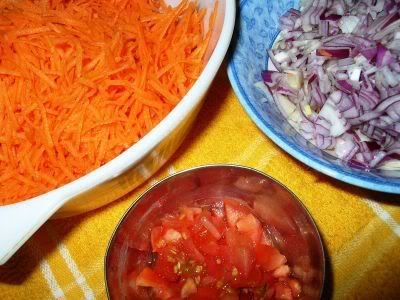
Carrot rice looks pretty and can be chilli-hot and carrot-sweet at the same time - the amount of heat, of course, depending on your tolerance for chillies.

Recipe for: Carrot rice
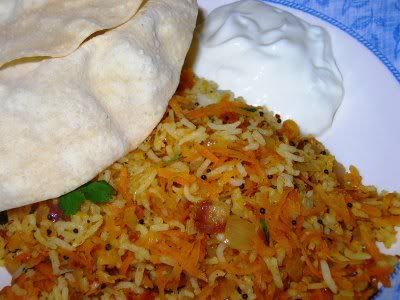
Ingredients:
Carrots, grated - 3 cups
Basmati rice, cooked - 2 cups
Two onions, chopped fine
One tomato, chopped fine
1 tsp mustard seeds
5 curry leaves
2 tbsp carrot rice masala powder
1 tbsp coriander leaves, chopped
2 tbsp roasted peanuts - for garnish (optional)
3 tsp oil
Salt to taste
Method:
1. Heat the oil in a wok, add the curry leaves and mustard seeds. Cover and let the seeds pop, then add the onions and cook till they begin to turn soft.
2. Add the chopped tomato and stir, cooking till it turns soft and mushy.
3. Now put in the grated carrot and salt to taste, stirring till the ingredients are well-mixed.
4. Sprinkle two tbsp of the carrot rice masala powder and mix it into the grated carrot mixture. Let this cook for 4-5 minutes, till the carrots change colour slightly.
5. Finally add the rice and carefully mix it into the carrot masala. Let it heat through, then sprinkle the chopped coriander leaves and garnish with the peanuts if using. Serve hot with any raita and salted potato crisps, pappadams or vadams.
Anyway, with just over a kilo of carrots to finish in the next couple of days, carrot rice inevitably found itself on the menu. It's very simple if you have the masala powder made beforehand, and the good thing is you can make extra powder that will come in handy another time. All you need to make carrot rice (apart from the carrots, haha) are a couple of onions and a tomato - items that usually are at hand in most kitchens.

Carrot rice looks pretty and can be chilli-hot and carrot-sweet at the same time - the amount of heat, of course, depending on your tolerance for chillies.

Recipe for: Carrot rice

Ingredients:
Carrots, grated - 3 cups
Basmati rice, cooked - 2 cups
Two onions, chopped fine
One tomato, chopped fine
1 tsp mustard seeds
5 curry leaves
2 tbsp carrot rice masala powder
1 tbsp coriander leaves, chopped
2 tbsp roasted peanuts - for garnish (optional)
3 tsp oil
Salt to taste
Method:
1. Heat the oil in a wok, add the curry leaves and mustard seeds. Cover and let the seeds pop, then add the onions and cook till they begin to turn soft.
2. Add the chopped tomato and stir, cooking till it turns soft and mushy.
3. Now put in the grated carrot and salt to taste, stirring till the ingredients are well-mixed.
4. Sprinkle two tbsp of the carrot rice masala powder and mix it into the grated carrot mixture. Let this cook for 4-5 minutes, till the carrots change colour slightly.
5. Finally add the rice and carefully mix it into the carrot masala. Let it heat through, then sprinkle the chopped coriander leaves and garnish with the peanuts if using. Serve hot with any raita and salted potato crisps, pappadams or vadams.
Saturday, December 10, 2005
Masala powder for carrot rice
This masala powder is very aromatic and keeps for a few months if stored in an airtight jar. The measures I'm giving here makes enough powder to use twice, but the amounts can easily be increased proportionally to make more.

Clockwise from the top: Urad dal, cinnamon stick, fennel seeds, chana dal, coriander seeds, cumin seeds. Centre (from left): Cloves, cardamom pod, black peppercorns
Recipe for: Masala powder for carrot rice
Ingredients:
2 tsp urad dal
2 tsp chana dal
2 tsp coriander seeds
1/2 tsp cumin seeds
1/2 tsp black peppercorns
1/2 tsp fennel seeds
1/2 inch stick cinnamon
2 cloves
1 cardamom pod
2 dried red chillies
5-6 curry leaves
1 tsp oil
Method:
1. Heat the oil in a pan and add all the items. Fry on medium heat, stirring frequently, until the dals turn golden and aromatic.
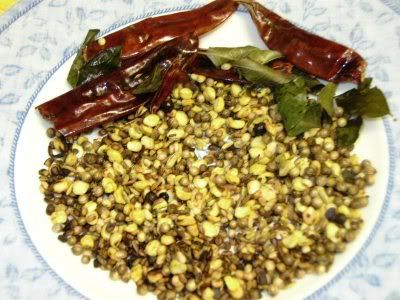
2. Let cool completely, then grind to a fine powder in a spice or coffee grinder. Store in an airtight jar for upto 6 months.

Clockwise from the top: Urad dal, cinnamon stick, fennel seeds, chana dal, coriander seeds, cumin seeds. Centre (from left): Cloves, cardamom pod, black peppercorns
Recipe for: Masala powder for carrot rice
Ingredients:
2 tsp urad dal
2 tsp chana dal
2 tsp coriander seeds
1/2 tsp cumin seeds
1/2 tsp black peppercorns
1/2 tsp fennel seeds
1/2 inch stick cinnamon
2 cloves
1 cardamom pod
2 dried red chillies
5-6 curry leaves
1 tsp oil
Method:
1. Heat the oil in a pan and add all the items. Fry on medium heat, stirring frequently, until the dals turn golden and aromatic.

2. Let cool completely, then grind to a fine powder in a spice or coffee grinder. Store in an airtight jar for upto 6 months.
Vattha kuzhambu (tamarind-based gravy for rice)
I believe there is vattha kuzhambu powder available for purchase in some places... and I know that some people have a recipe for it. I'm not one of them. I make vattha kuzhambu like my mother does - with good old sambar powder. One thing to note - the sambar powder I use is the original stuff that I get from India, ground to a fine powder in a proper mill. I havent tried making vattha kuzhambu using MTR or GITS or any of those other ready-made varieties of sambar powder.
Anyway, in my opinion, you gotta add two kinds of dried berries to make an authentic vattha kuzhambu - marathakkalikai and chundakkai.
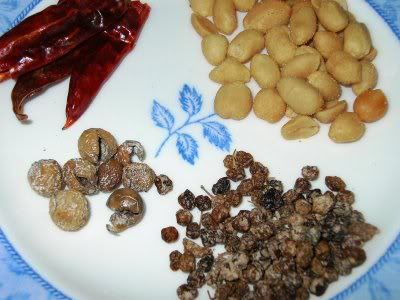
Clockwise from bottom right: Marathakkali, chundakkai, dried red chillies, roasted peanuts
Again, these are most likely acquired tastes. Chundakkai, especially, are really bitter if you bite into them... but I do like the overall aroma and the flavour they impart to the kuzhambu. Marathakali are much more my favourite - fried and mixed with ghee and rice, they're really rather yummy. Better yet, they're also supposed to be good for you. For cleansing the blood, or something like that. Okay, I really need to find out more about them. Watch this space.
Because vattha kuzhambu is not made with any significant amount of dal, South Indians get their protein by pairing it with paruppu thogayal - somewhat like hummous, but made with tuvar dal and bengal gram dal, rather than cooked chickpeas. It's usually bland. I havent had it or made it in years, to tell the truth, because I personally prefer to make beans or cabbage paruppu usili as an accompaniment. Keerai (spinach) is another good side-dish for this kuzhambu.
Recipe for: Vattha kuzhambu
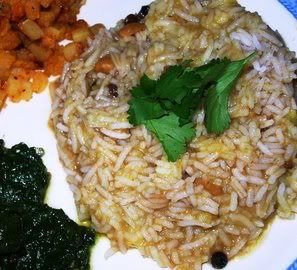
Ingredients:
1 tsp tamarind paste, dissolved in 4 cups warm water
2 tsp sambar powder
1 tsp tuvar dal
1-2 tsp dried marathakkali berries
4-5 dried chundakkai
10-12 fenugreek seeds
1 tsp mustard seeds
2 dried red chillies, broken in half
1/2 tsp red chilli powder (optional)
3/4 tsp freshly ground black pepper
2-3 tsp oil
4-5 curry leaves
pinch of asafoetida
2 tbsp roasted de-skinned peanuts
1 tbsp rice flour or cornflour (for thickening the gravy if required)
Salt to taste
Method:
1. Heat the oil in a pan and fry the dried berries for 30 seconds or so.
2. Add the asafoetida, dry red chillies, curry leaves, mustard seeds, fenugreek seeds and tuvar dal to the oil and stir. Fry till the mustard seeds pop and the tuvar dal turns golden brown. The berries should be dark brown now, but be careful that they dont burn.
3. Add the sambar powder, ground black pepper and red chilli powder (if using) and stir. Then pour in the tamarind water.
4. If you are using the peanuts, drop those in as well and let the tamarind water boil for 15-20 minutes or until it has reduced by a third.
5. Mix the cornflour/rice flour with some water to make a pourable paste, and stir it into the kuzhambu. Add salt to taste.
6. Boil it for another 5 minutes, until it is the consistency you like.
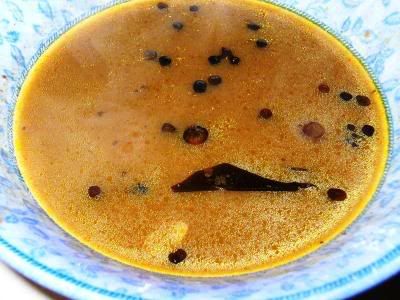
7. Serve hot with steamed rice, keerai and paruppu usili or - for an extra special touch - pan-fried potatoes Indian style.
Anyway, in my opinion, you gotta add two kinds of dried berries to make an authentic vattha kuzhambu - marathakkalikai and chundakkai.

Clockwise from bottom right: Marathakkali, chundakkai, dried red chillies, roasted peanuts
Again, these are most likely acquired tastes. Chundakkai, especially, are really bitter if you bite into them... but I do like the overall aroma and the flavour they impart to the kuzhambu. Marathakali are much more my favourite - fried and mixed with ghee and rice, they're really rather yummy. Better yet, they're also supposed to be good for you. For cleansing the blood, or something like that. Okay, I really need to find out more about them. Watch this space.
Because vattha kuzhambu is not made with any significant amount of dal, South Indians get their protein by pairing it with paruppu thogayal - somewhat like hummous, but made with tuvar dal and bengal gram dal, rather than cooked chickpeas. It's usually bland. I havent had it or made it in years, to tell the truth, because I personally prefer to make beans or cabbage paruppu usili as an accompaniment. Keerai (spinach) is another good side-dish for this kuzhambu.
Recipe for: Vattha kuzhambu

Ingredients:
1 tsp tamarind paste, dissolved in 4 cups warm water
2 tsp sambar powder
1 tsp tuvar dal
1-2 tsp dried marathakkali berries
4-5 dried chundakkai
10-12 fenugreek seeds
1 tsp mustard seeds
2 dried red chillies, broken in half
1/2 tsp red chilli powder (optional)
3/4 tsp freshly ground black pepper
2-3 tsp oil
4-5 curry leaves
pinch of asafoetida
2 tbsp roasted de-skinned peanuts
1 tbsp rice flour or cornflour (for thickening the gravy if required)
Salt to taste
Method:
1. Heat the oil in a pan and fry the dried berries for 30 seconds or so.
2. Add the asafoetida, dry red chillies, curry leaves, mustard seeds, fenugreek seeds and tuvar dal to the oil and stir. Fry till the mustard seeds pop and the tuvar dal turns golden brown. The berries should be dark brown now, but be careful that they dont burn.
3. Add the sambar powder, ground black pepper and red chilli powder (if using) and stir. Then pour in the tamarind water.
4. If you are using the peanuts, drop those in as well and let the tamarind water boil for 15-20 minutes or until it has reduced by a third.
5. Mix the cornflour/rice flour with some water to make a pourable paste, and stir it into the kuzhambu. Add salt to taste.
6. Boil it for another 5 minutes, until it is the consistency you like.

7. Serve hot with steamed rice, keerai and paruppu usili or - for an extra special touch - pan-fried potatoes Indian style.
Wednesday, December 07, 2005
Keerai (spinach) with karuvadam - South Indian style
Well, when I say "South Indian style", I really mean "my mother's style", but it's not far off the truth as descriptions go - I mean, my mother IS South Indian, and it IS her style. Heh.
I'll also say this - spinach cooked this way is probably an acquired taste unless you REALLY love the taste. I quite like spinach, plus I've acquired the taste, so I face no problems whatsoever!
Ideally, the two ingredients that would make this completely authentic are: 1. mor molagai - green chillies that have been soaked in salt and buttermilk (dont know the recipe myself - and not likely to make it either, because of a lack of strong sunshine in these here parts...) and sundried. These are fried in oil and sometimes used to season certain dishes, but more usually eaten as an accompaniment with yogurt and rice, rather like appalam/poppadum.
2. Karuvadam - these are usually made with pumpkin and spiced up with red chillies. I dont know what else goes into the recipe, but again, they are dried in the sun and stored away. They make their appearance occasionally, fried and added to certain dishes - like keerai. I'm not sure if karuvadam have any equivalent in western cuisine, so I dont have a comparable to explain with. They're very intense in flavour, so a little goes a long way.
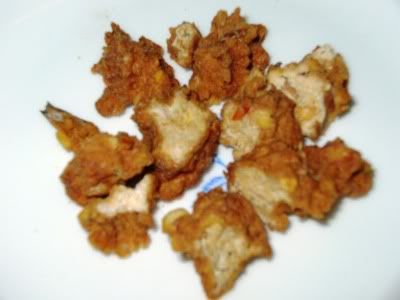
Of the two items, I had the karuvadam - a small stash which I used up boldly in the certain knowledge that I will be replenishing my stock very soon on my India trip!
Keerai made this way is a classic accompaniment for vattha kuzhambu and rice. I had an added extra - simple pan-fried potatoes.
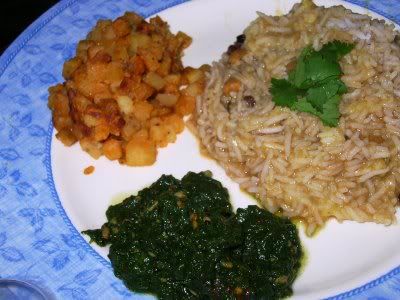
Oh by the way... keerai can be made without the karuvadam, too. They arent essential, just a tasty extra.
Recipe for: Keerai with karuvadam
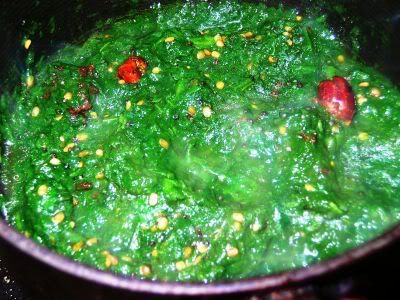
Ingredients:
3 cups spinach, chopped, washed and drained
Karuvadam - about 4-5 pieces
2-3 dry red chillies - or 4-5 mor molagai pieces, if you be so lucky as to have them!
2 tsp urad dal
1 tsp mustard seeds
Salt to taste
Pinch of asafoetida
3-4 tbsp vegetable or sunflower oil to fry the karuvadam and mor molagai
1 tsp coconut oil (Indian brands like Parachute, etc) - optional
Method:
1. Cook the keerai with 3-4 tbsp water in a closed pan till wilted. Let it cool. You can now mash it for a robust texture or run it in the blender a couple of times till it's pureed. I prefer an in-between texture - not too rough but not completely smooth, either.
2. Put the keerai back in the pan along with salt to taste, and let it simmer on low along with 1/3 cup water.
3. Heat the vegetable oil in a small pan and fry the karuvadam and mor molagai (if using). Remove from oil and set aside for the moment.
4. Spoon out most of the remaining oil, leaving about a tsp in the pan. Add the asafoetida, mustard seeds, urad dal and the dry red chillies. Cover the pan and let the seeds splutter and the urad dal turns light brown.
5. Pour this seasoning directly on the keerai and mix well. Add the karuvadam and turn the heat off. Pour the tsp of coconut oil over the keerai and mix again. Serve hot as a side dish with vattha kuzhambu and rice.
I'll also say this - spinach cooked this way is probably an acquired taste unless you REALLY love the taste. I quite like spinach, plus I've acquired the taste, so I face no problems whatsoever!
Ideally, the two ingredients that would make this completely authentic are: 1. mor molagai - green chillies that have been soaked in salt and buttermilk (dont know the recipe myself - and not likely to make it either, because of a lack of strong sunshine in these here parts...) and sundried. These are fried in oil and sometimes used to season certain dishes, but more usually eaten as an accompaniment with yogurt and rice, rather like appalam/poppadum.
2. Karuvadam - these are usually made with pumpkin and spiced up with red chillies. I dont know what else goes into the recipe, but again, they are dried in the sun and stored away. They make their appearance occasionally, fried and added to certain dishes - like keerai. I'm not sure if karuvadam have any equivalent in western cuisine, so I dont have a comparable to explain with. They're very intense in flavour, so a little goes a long way.

Of the two items, I had the karuvadam - a small stash which I used up boldly in the certain knowledge that I will be replenishing my stock very soon on my India trip!
Keerai made this way is a classic accompaniment for vattha kuzhambu and rice. I had an added extra - simple pan-fried potatoes.

Oh by the way... keerai can be made without the karuvadam, too. They arent essential, just a tasty extra.
Recipe for: Keerai with karuvadam

Ingredients:
3 cups spinach, chopped, washed and drained
Karuvadam - about 4-5 pieces
2-3 dry red chillies - or 4-5 mor molagai pieces, if you be so lucky as to have them!
2 tsp urad dal
1 tsp mustard seeds
Salt to taste
Pinch of asafoetida
3-4 tbsp vegetable or sunflower oil to fry the karuvadam and mor molagai
1 tsp coconut oil (Indian brands like Parachute, etc) - optional
Method:
1. Cook the keerai with 3-4 tbsp water in a closed pan till wilted. Let it cool. You can now mash it for a robust texture or run it in the blender a couple of times till it's pureed. I prefer an in-between texture - not too rough but not completely smooth, either.
2. Put the keerai back in the pan along with salt to taste, and let it simmer on low along with 1/3 cup water.
3. Heat the vegetable oil in a small pan and fry the karuvadam and mor molagai (if using). Remove from oil and set aside for the moment.
4. Spoon out most of the remaining oil, leaving about a tsp in the pan. Add the asafoetida, mustard seeds, urad dal and the dry red chillies. Cover the pan and let the seeds splutter and the urad dal turns light brown.
5. Pour this seasoning directly on the keerai and mix well. Add the karuvadam and turn the heat off. Pour the tsp of coconut oil over the keerai and mix again. Serve hot as a side dish with vattha kuzhambu and rice.
Labels:
asafoetida,
coconut oil,
dry red chillies,
karuvadam,
mustard seeds,
spinach,
urad dal
Tuesday, December 06, 2005
Paneer palak (spinach) subji
Looks like the next few posts are going to be mainly "empty the fridge" types, as I'm off to India next Tuesday, for a fortnight.
Today, as the first of the use-'em-up recipes, I made an impromptu side-dish using one of the two bunches of spinach that were wilting quietly in the fridge. Two red onions, two tomatoes, half a cup of cubed paneer and a few spices and condiments later, there it was - a healthy side-dish to go with the methi (fenugreek greens) chapatis that we had for dinner.
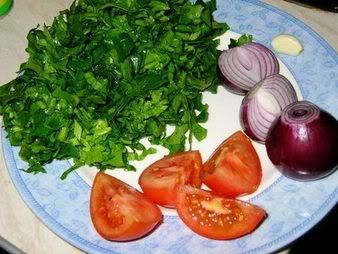
Recipe for: Paneer palak subji

Ingredients:
Fresh spinach - washed, drained and chopped - 4 cups
1/2 cup paneer, cubed
2 onions, sliced thinly
1 tomato, chopped
2 cloves garlic, slivered
1/2 tsp ginger root, grated
1/2 tsp fresh ground pepper
2 fresh green chillies (as per taste), sliced thin
OR
1/2 tsp chilli powder
1 tsp cumin seeds
1/2 tsp garam masala
Salt to taste
3 tsp oil
Method:
1. Heat 1 tsp oil in a pan and stir-fry the paneer till the cubes turn reddish-golden. Remove from the heat and reserve.
2. In the same pan, heat the remaining oil. Add the ginger root, the garlic, cumin seeds, chilli powder/green chillies and fry for about 30 seconds, till the cumin seeds turn brown and aromatic.
3. Now add the salt, garam masala, ground pepper and the sliced onions. Fry till the onions start becoming soft.
4. Add the chopped tomato and fry for a minute.
5. Finally add the spinach and sprinkle two tbsp water and cover the pan. Lower the heat and let the spinach wilt for 4 minutes or so.
6. Stir the contents so the spinach and onions are well mixed, then add the fried paneer. Add 1/3 cup water, stir and simmer the subji on medium heat for another 3 minutes or so, until the spinach is cooked.
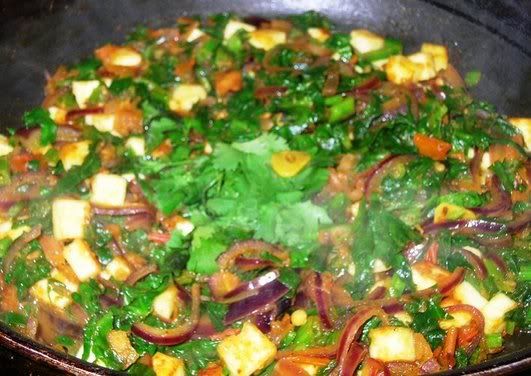
7. Serve hot with a dollop of cream or Greek yogurt, as an accompaniment for rotis/parathas.
Today, as the first of the use-'em-up recipes, I made an impromptu side-dish using one of the two bunches of spinach that were wilting quietly in the fridge. Two red onions, two tomatoes, half a cup of cubed paneer and a few spices and condiments later, there it was - a healthy side-dish to go with the methi (fenugreek greens) chapatis that we had for dinner.

Recipe for: Paneer palak subji

Ingredients:
Fresh spinach - washed, drained and chopped - 4 cups
1/2 cup paneer, cubed
2 onions, sliced thinly
1 tomato, chopped
2 cloves garlic, slivered
1/2 tsp ginger root, grated
1/2 tsp fresh ground pepper
2 fresh green chillies (as per taste), sliced thin
OR
1/2 tsp chilli powder
1 tsp cumin seeds
1/2 tsp garam masala
Salt to taste
3 tsp oil
Method:
1. Heat 1 tsp oil in a pan and stir-fry the paneer till the cubes turn reddish-golden. Remove from the heat and reserve.
2. In the same pan, heat the remaining oil. Add the ginger root, the garlic, cumin seeds, chilli powder/green chillies and fry for about 30 seconds, till the cumin seeds turn brown and aromatic.
3. Now add the salt, garam masala, ground pepper and the sliced onions. Fry till the onions start becoming soft.
4. Add the chopped tomato and fry for a minute.
5. Finally add the spinach and sprinkle two tbsp water and cover the pan. Lower the heat and let the spinach wilt for 4 minutes or so.
6. Stir the contents so the spinach and onions are well mixed, then add the fried paneer. Add 1/3 cup water, stir and simmer the subji on medium heat for another 3 minutes or so, until the spinach is cooked.

7. Serve hot with a dollop of cream or Greek yogurt, as an accompaniment for rotis/parathas.
Labels:
black pepper powder,
cumin seeds,
garam masala,
garlic,
Ginger,
green chillies,
onions,
paneer,
spinach,
tomatoes
Subscribe to:
Comments (Atom)

